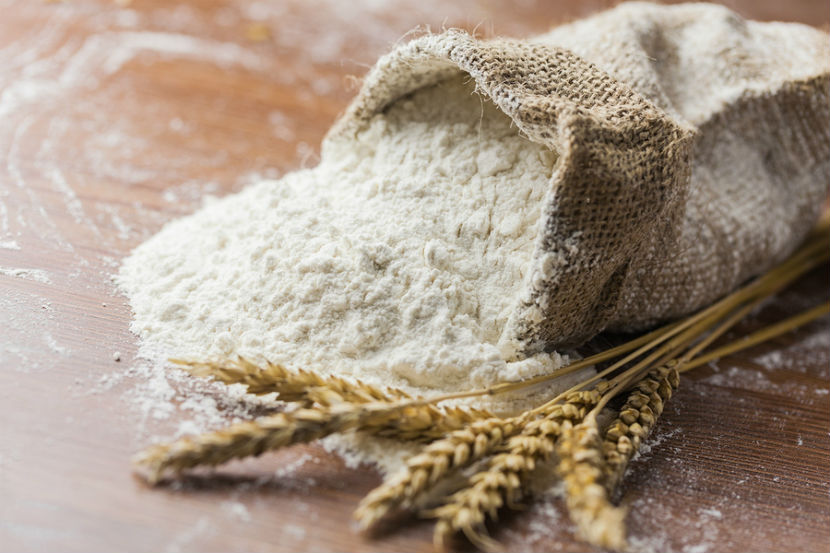
There are many types of flour we can use in home baking and some are more nutritious than others. This practical guide shows you how to buy, store, use and substitute different types of flour made from grains.
Types of flour
Flour can be made from grains, legumes, nuts, and even vegetables such as potato flour. This article reviews flours made with grains.
Whole grain flours
Whole grain flours have all three parts of the kernel (the bran, germ and endosperm) and have more fibre, vitamins and minerals than “refined” flours. Here is a list of whole grain flours:
-
Amaranth*
-
Barley
-
Brown rice*
-
Buckwheat*
-
Corn*
-
Millet*
-
Oats
-
Quinoa*
-
Rye
-
Spelt
*Gluten-free whole grain options. For information on oats and gluten read here.
A note about whole wheat flour
Whole wheat flour is not a whole grain. It has some of the bran and most of the germ removed. Whole grain, whole wheat flour is a whole grain but is not widely available. Try a larger grocery store or health food store to find this flour.
Is multigrain a whole grain?
Not always. Foods are labelled multigrain when they are made from more than one grain – for example, wheat flour mixed and rice flour. To know if a food product is made with whole grains, read the ingredient list and look for foods that have the words “whole grain” followed by the name of the grain. For example, “whole grain wheat”, “whole grain oats”.
Refined wheat flours
These flours have the bran and germ removed, and are not as nutritious as whole grain flours.
-
Bread flour is made with “hard” wheat, which is higher in protein. The higher protein in this flour makes it ideal for yeast breads.
-
Pastry or cake flour is made with “soft” wheat, which is lower in protein. The lower protein in this flour makes it ideal for making tender cakes, cookies, pastries and pasta.
-
All purpose flour is made from a blend of “hard” and “soft” wheat grains. It is used to make a variety of baked goods including muffins, cakes, pastries and waffles.
Buying local flour
To know if your flour came from a farm in Canada look for “Product of Canada” on the package label. That tells you the flour came from a farm in Canada. When you buy local food, you support farmers so they can keep producing high quality, affordable food we can all enjoy.
Buy it best
Tips for storing flour
-
Store flour in a cool, dry place such as a pantry, fridge or freezer.
-
Once opened, transfer flour to an air-tight container.
-
Use by the “best before” or “sell by” date.
Nutrition
Canada’s Food Guide recommends we choose whole grains at every meal. Whole grains are a source of fibre, vitamins and minerals. Try to make a quarter of your meal using whole grains like brown rice, quinoa, corn, whole grain naan and whole grain pasta. Substituting some refined flour for whole grain flour makes baked goods more nutritious. Whole wheat flour is not a whole grain but it does have more fibre than all purpose flour.
Tips for using different types of flour
For more nutritious yeast breads, replace ¼ of the all purpose flour with any of these flours:
Note: wheat germ can replace 1/3 of wheat flour in yeast breads. For more nutritious baked goods like muffins, scones or quick breads, replace ½ of the all purpose flour with any of these flours:
-
Barley
-
Buckwheat
-
Quinoa
-
Whole wheat
-
Oats
Give your baking a nutritional and flavourful boost. Choose whole grain recipes with:
-
Fruit (pumpkin, peaches, apples, berries, dates)
-
Vegetables (carrot, zucchini, sweet potato)
-
Nuts (walnuts, almonds and nut flours)
-
Seeds (flax, chia, pumpkin, sunflower)
-
Fresh or dried herbs (basil, oregano, thyme, parsley)
Things to do with flour
-
Make your own baked goods like scones, muffins and quick breads. Your house will smell terrific and you’ll save money too. Try: Whole wheat orange ginger scones, Swedish knäckebröd or Flying Saucer Muffins.
-
Make your own pizza dough, pancake and waffle mixes. It’s easy and you can choose better-for-you recipes, too. Try these Masa Corn Pancakes or these Banana Whole Grain Griddle Cakes.
-
Make baked eggplant or zucchini sticks by making a breading mixture using your favourite whole grain flour. Use this recipe as a guide.
-
Make a cheese sauce. Over low heat, melt butter or margarine in a small pot. Whisk in an equal amount of all purpose flour to make a paste and keep stirring for a few minutes. Whisk in milk then grated cheese a little at a time until smooth. Use the cheese sauce to top whole grain pasta and serve with a salad for a quick and balanced meal.
How can a dietitian help?
Dietitians can support you throughout many phases of your life from pregnancy to eating well when you are older. Counselling sessions with a dietitian can also help you to prevent and treat healthy conditions like diabetes and heart disease. Your dietitian will work with you to give you personalized advice that meets your lifestyle and goals. Connect with a dietitian today!
Bottom line
Use whole grain flours like barley, oats, quinoa and rye to get a nutritional boost! When grocery shopping, read the ingredient list of food products to look for the words “whole grain.”
You may also be interested in:
Choosing Whole Grains FAQs
All About Whole Grains
What Can I Expect When I Go and See a Dietitian?
This article was written and reviewed by dietitians from Dietitians of Canada. The advice in this article is intended as general information and should not replace advice given by your dietitian or healthcare provider.
Last Update – December 20, 2022